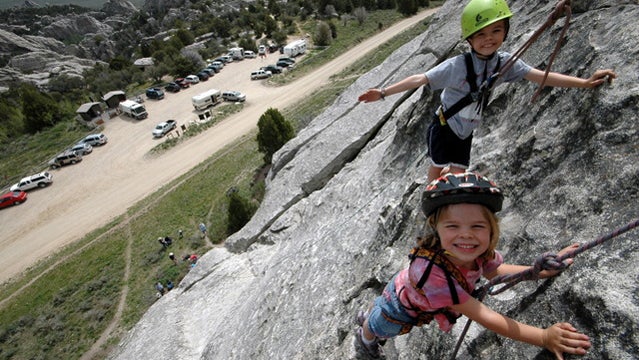We’re leaving this weekend for a two-day backcountry ski trip to in the San Juan Mountains in southern Colorado. It’s part of our New Year’s resolution to camp every month with our children. But as we prep our gear, rig our bike trailers with skis, plot our menus, and talk up the thrill of spending two nights sleeping in a glorified, canvas-walled wilderness tent, I can’t help but wonder if our kids are as excited as we are.
Raising Rippers
Katie Arnold and guests write regularly on family adventure and bringing up active children. Lake 8522, Sawtooth Mountains, Idaho.
Lake 8522, Sawtooth Mountains, Idaho.Probably not—or at least not in the same way we are. After all, they’re two and four. The last time we skied into a yurt, our younger daughter was 18 months, too little to remember. They don’t know that Spruce Hole has access to some great, low-angle ski runs through the trees, in four feet of fresh powder, or even what that means. They can’t anticipate the peace that will come from being away from all-things electronic for two days. They’re more interested in choosing what kinds of treats we’ll bring, which stuffed animal to pack, and how we’re going to tow their plastic sled to the yurt. No doubt they’d be just as happy staying here, skiing at our local mountain, and playing Candy Land with our six-year-old neighbor.
But we go, so they go. It’s so much better together. And I know they’re growing up with adventure in their blood. It’s what we do, and what they know. They love splashing in the mud on river trips, don’t think twice about getting filthy when we camp, and never balk at swimming in chilly, brown desert rivers. We’re lucky—so far. Kids are mercurial. I’m aware that everything could change. I don’t wanna go! Then what?
My colleague Michael Lanza, who created the family adventure blog , recently wrote a terrific story about how to cultivate in your children a genuine love of being outside. His kids are older than ours, and by now they are adventure kids by choice—their choice. Below are his top three tips. For seven more great ideas, read his at The Big �����ԹϺ���.
DITCH THE STROLLER
As soon as your toddler can walk, give some friends that stroller and let your child walk everywhere you go, whether around town or on a trail. Sure, walking with a little one requires patience. But it turns children into strong hikers at a young age and gets them used to the idea that they will walk rather than be carried.
I preferred a child-carrier backpack to a stroller, even in urban settings, for those occasions when my kids needed a break from walking. It gives you exercise, is more convenient on stairs, and helps communicate to kids that our family carries packs—that we’re hikers.
DON’T GIVE IN TO FRUSTRATION
Hiking, camping, or doing almost anything outdoors with babies, toddlers, and preschoolers is often more work than fun. Don’t get discouraged; take them out anyway. If you wait until they’re older you may find that your child isn’t interested. Introduce children to the outdoors while they’re very young and make it part of your family lifestyle, so that you nurture in them a long-term love for it.
TAKE BABY STEPS
Don’t push your kids too hard. This one’s especially hard for parents who have always been very active, but pushing them risks creating a negative association with the outdoors. Start small, with short hikes, and work gradually up to longer outings. Think of it as pulling them along rather than pushing them. What’s familiar and easy to you may seem scary and intimidating to a kid. Evaluate your child’s readiness for something new based not just on its physical difficulty, but how well your child handled previous experiences that presented comparable stress.
Michael Lanza gives talks and slideshow presentations about taking kids into the wilderness. His book about taking his young kids on 11 wilderness adventures in national parks facing threats from climate change, , is available from Beacon Press.


